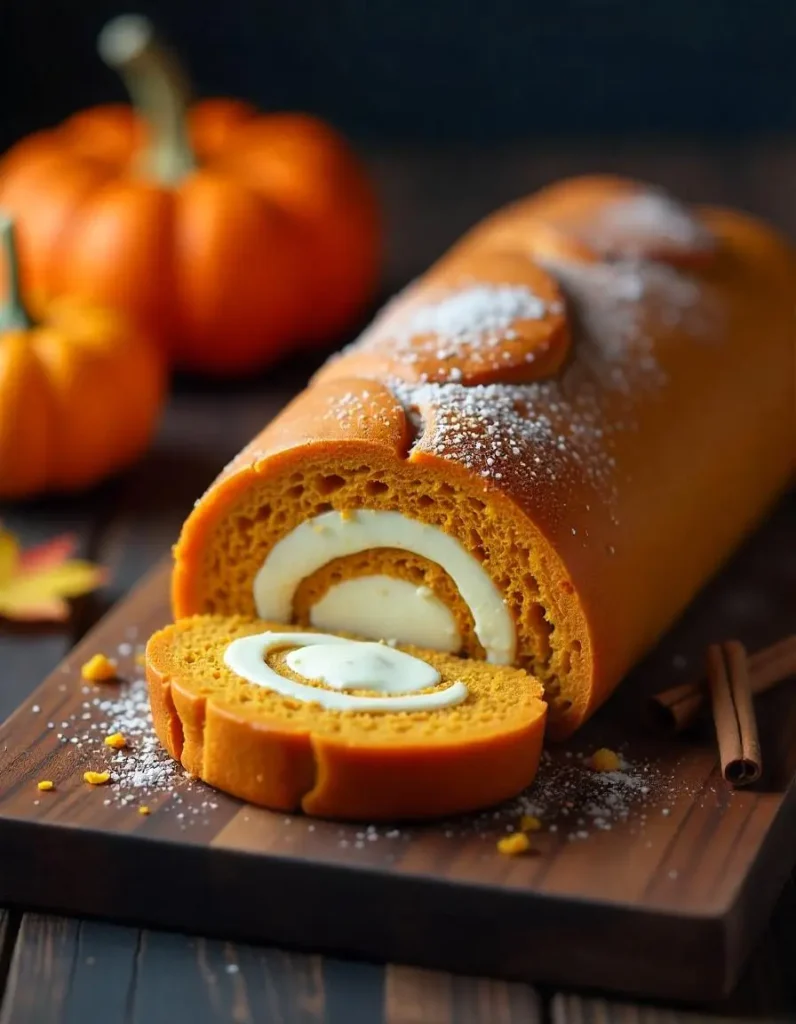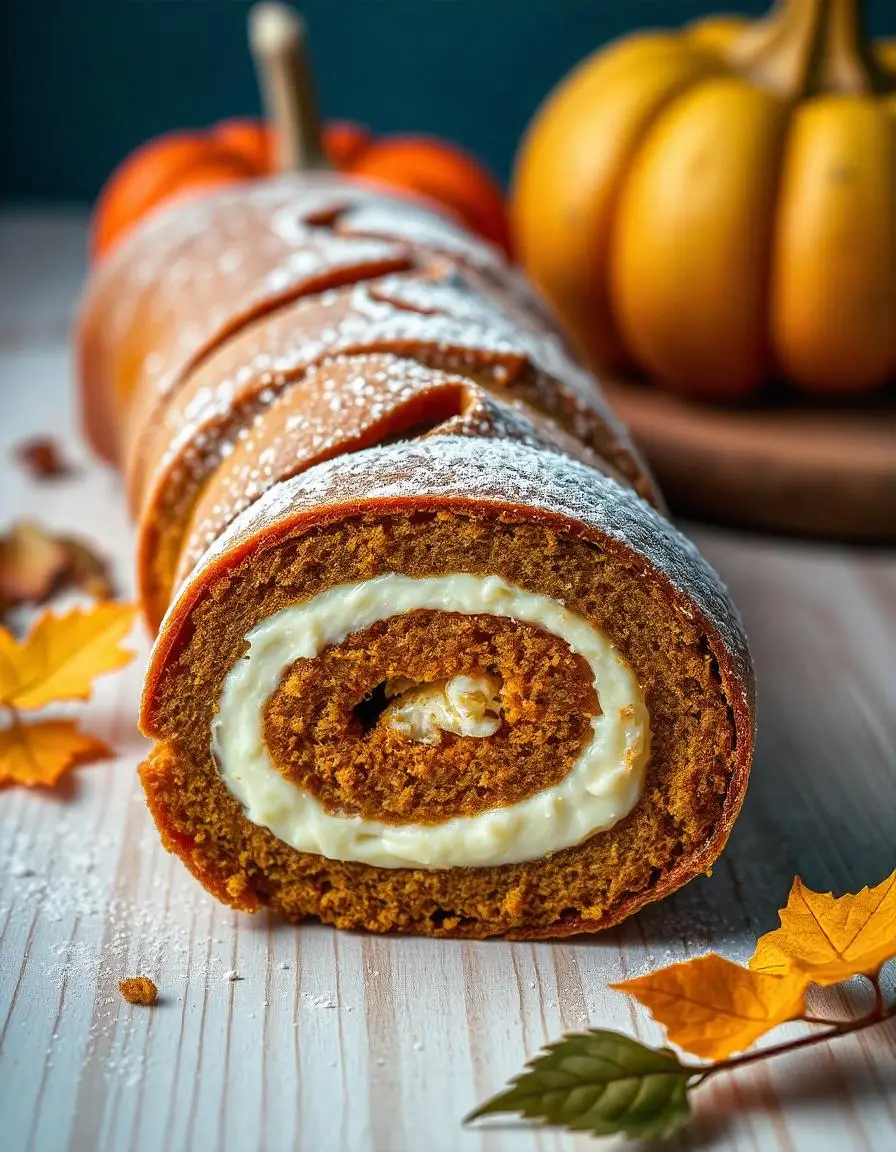Introduction
Pumpkin rolls are a beloved fall dessert, known for their delicious blend of pumpkin, spices, and creamy filling. However, many bakers struggle with a common problem: cracks in the pumpkin roll when they try to roll it up. If you’ve ever faced this issue, you know how frustrating it can be when your perfectly baked pumpkin roll doesn’t look as beautiful as you hoped. But fear not – there are several reasons why this might happen, and even better, there are solutions to ensure your next pumpkin roll is picture-perfect.
In this article, we’ll explore the common causes of cracked pumpkin rolls and provide actionable tips to help you avoid them. Whether you’re a seasoned baker or a beginner, these expert techniques will ensure that your pumpkin roll turns out flawlessly every time. Let’s dive into the reasons why your pumpkin roll cracks and how to prevent it.
Understanding the Pumpkin Roll
A pumpkin roll is a type of sponge cake made with a mixture of pumpkin puree, eggs, flour, sugar, and spices like cinnamon and nutmeg. It’s baked as a thin sheet, and once cooled, it is carefully rolled with a creamy filling made of cream cheese or whipped cream.
The texture of the pumpkin roll is light and airy, which allows it to be rolled without breaking – but this delicate structure is also what makes it prone to cracking if not handled properly. Understanding how the cake’s structure works is key to preventing cracking, as small mistakes during the baking and rolling process can lead to unsightly cracks in your final product.

Common Causes of Cracking in Pumpkin Rolls
Overbaking the Cake
Overbaking is one of the leading causes of cracks in a pumpkin roll. When you bake the cake for too long, it becomes too dry, which makes it less flexible and more prone to breaking when rolled.
How to prevent it: Make sure to bake the pumpkin cake for the right amount of time, usually around 15-20 minutes at 350°F (175°C). The cake should be set and spring back when lightly pressed, but still soft and slightly moist to the touch. If you find that your cake is overbaked, you’ll need to adjust the baking time for future attempts.
Not Cooling the Cake Properly
Proper cooling is another critical factor in preventing cracks in your pumpkin roll. If you don’t let the cake cool completely or if you roll it up too early while it’s still hot, it will crack when you try to shape it.
How to prevent it: After baking, let the pumpkin roll cool on a clean kitchen towel dusted with powdered sugar. Allow the cake to cool in the towel for at least 10 minutes before gently rolling it into a log shape. This technique helps retain moisture and ensures the cake remains pliable enough to be rolled without cracking.
Too Much Flour or Sugar in the Recipe
Too much flour or sugar in your pumpkin roll recipe can make the batter too stiff, resulting in a cake that is too thick and not as flexible. This could cause it to crack when you try to roll it.
How to prevent it: Follow the recipe carefully and measure your ingredients correctly. It’s important to use the right balance of flour, sugar, and other ingredients to ensure the right cake texture. If you’re experimenting with different recipes, make sure to test and tweak proportions to get the right consistency.
The Rolling Technique
How you roll your pumpkin roll can greatly affect whether it cracks or not. Rolling it too tightly, too quickly, or unevenly can all lead to cracks. It’s crucial to roll gently and with care to ensure the structure holds up.
How to prevent it: Always roll your pumpkin roll gently, starting from one edge and working your way across. Be sure to apply even pressure to avoid uneven rolling, which can lead to cracks. Roll it up slowly and carefully to avoid over-stretching the cake. A tight roll is unnecessary – the goal is to form a loose, even spiral.
The Thickness of the Cake
If the cake batter is too thick or too thin, it can affect how well the roll holds together. A thick batter can be harder to roll and may crack due to lack of flexibility, while a thin batter can cause the cake to be too fragile.
How to prevent it: Stick to the recommended measurements in your recipe, as this will ensure the correct batter consistency. Aim for a batter that is pourable but not runny. If you’re using a different type of flour or adding ingredients, this could change the cake’s texture and make it more prone to cracking.
Tips to Prevent Cracking in Your Pumpkin Roll
Perfect Your Baking Time and Temperature
As mentioned earlier, overbaking can cause the cake to crack. To prevent this, always check the baking time and temperature carefully. It’s better to slightly underbake than to overbake. Use an oven thermometer to ensure accurate temperature, as oven heat can vary from one appliance to another.
Cool Your Cake Right
Cooling the cake properly is essential. After removing the pumpkin roll from the oven, immediately place it on a clean kitchen towel sprinkled with powdered sugar. Let it cool for at least 10-15 minutes before you attempt to roll it. This gives it time to firm up while still being soft enough to roll.
Use the Right Amount of Flour
Measure your flour carefully using a kitchen scale or spoon-and-level method. Too much flour can make the batter too stiff and increase the likelihood of cracks. On the other hand, too little flour can make the batter too runny, which could affect the final result.
Roll with Care
Gently roll the pumpkin cake once it’s cooled. Start at one edge and slowly and carefully roll the cake to the other side, without applying too much pressure. You don’t need to roll tightly – a loose spiral is sufficient. Using a kitchen towel can also help with the rolling process.
Work with the Right Cake Thickness
Ensure the batter is spread evenly in the baking pan, with a uniform thickness. The cake should be thick enough to hold together but not so thick that it becomes stiff. If you’re unsure, err on the side of slightly thinner layers to ensure flexibility.

How to Fix a Cracked Pumpkin Roll
Even the most careful bakers may experience the occasional crack. If you end up with a cracked pumpkin roll, don’t despair – there are ways to salvage it. Here are some tips:
- Use the filling to cover cracks: If your pumpkin roll cracks while rolling, you can spread the cream cheese filling over the cracks. This can help seal the cracks and improve the appearance.
- Cut and reassemble: If the crack is too severe, you can cut the roll into smaller slices and reassemble them on a serving plate, covering with extra filling to make it look intentional.
- Freeze the roll: If you can’t fix the crack right away, place the roll in the freezer for about 30 minutes. This can make it easier to handle and roll further without it falling apart.
Frequently Asked Questions (FAQ)
Q1: Why does my pumpkin roll crack when I roll it?
A: The most common reasons for cracking include overbaking the cake, not allowing it to cool properly, rolling it too tightly, or having the wrong cake thickness. Overbaked cakes are too dry and brittle to roll without breaking. Ensure you bake the cake just enough to set it without drying it out, cool it correctly, and roll it gently for the best results.
Q2: How can I prevent cracks in my pumpkin roll?
A: To prevent cracks, ensure the following:
- Bake correctly: Don’t overbake the cake. Bake at 350°F for about 15-20 minutes, checking for doneness by pressing lightly on the center.
- Cool properly: Let the cake cool for at least 10-15 minutes before rolling.
- Roll gently: Don’t roll the cake too tightly. Start from one edge and roll loosely but evenly.
- Correct batter consistency: Make sure the batter isn’t too thick or too thin.
Q3: Can I use a different filling for my pumpkin roll?
A: Yes! While cream cheese filling is the classic choice, you can experiment with whipped cream, mascarpone cheese, or even a flavored buttercream. Just ensure the filling is thick enough not to spill out when you roll the cake.
Q4: How long should I let my pumpkin roll cool before rolling it?
A: After baking, let your pumpkin roll cool on a clean kitchen towel for about 10-15 minutes. If you try to roll it while it’s still too hot, it will be more prone to cracking. Cooling the cake makes it more pliable and prevents the filling from melting.
Q5: My pumpkin roll cracked even though I followed the recipe. What can I do?
A: Sometimes, even with the best precautions, cracks can happen. If this occurs, don’t worry:
- Patch the crack with filling: You can use extra cream cheese filling to cover cracks and hide them.
- Reassemble the pieces: If the roll breaks into pieces, you can place them back together like a cake or mini roll and cover with more filling to disguise the cracks.
Q6: Can I freeze a pumpkin roll?
A: Yes! Pumpkin rolls freeze very well. To freeze:
- Freeze unrolled cake: If you want to freeze the pumpkin roll before rolling it, wrap the cooled cake tightly in plastic wrap, then foil. Thaw in the refrigerator before filling and rolling.
- Freeze filled pumpkin roll: You can freeze a fully rolled pumpkin roll too. Wrap it tightly in plastic wrap and then in foil. Thaw in the refrigerator overnight before serving.
Q7: What is the best way to store a pumpkin roll?
A: After rolling, store the pumpkin roll in the refrigerator to keep the filling fresh. It can last for about 3-4 days in the fridge. If you need to store it for longer, freezing it is a great option. Always wrap it tightly in plastic wrap or foil to preserve its moisture.
Q8: Why is my pumpkin roll too dry?
A: If your pumpkin roll is dry, it may have been overbaked or not had enough moisture in the batter. To avoid dryness, bake the cake for the recommended time and check the consistency of the batter before pouring it into the pan. Consider adding a bit more pumpkin puree or adjusting the baking time next time.
Q9: Can I make the pumpkin roll ahead of time?
A: Yes, you can make the pumpkin roll a day or two in advance. Just wrap it tightly in plastic wrap and store it in the refrigerator. It will taste even better as the flavors meld together. If freezing, be sure to thaw it in the refrigerator before serving.
Conclusion
A cracked pumpkin roll doesn’t have to ruin your dessert. With the right technique and a few adjustments to your baking process, you can create a perfect, crack-free pumpkin roll that will impress your friends and family. Keep these tips in mind: bake with care, cool your cake properly, measure your ingredients carefully, and roll gently. Even if you experience cracks, don’t worry – there are ways to fix it.
By applying these techniques and practicing patience, you’ll soon be able to roll up a pumpkin roll that’s as beautiful as it is delicious. Happy baking!

